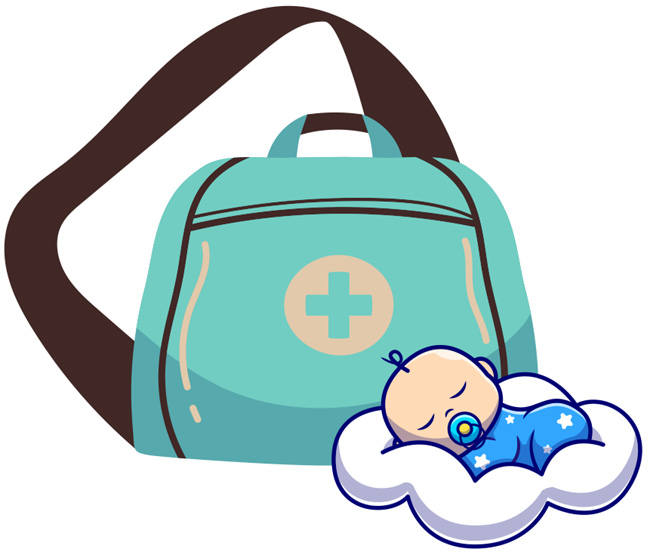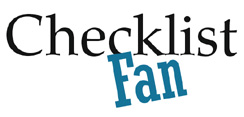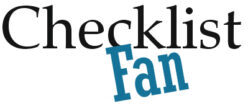
Childbirth is an intense experience, and you want to feel as comfortable as possible. Pack everything you need for a hospital birth in a hospital bag. Because labor can start at any time of the day or night, pack your hospital bag ahead of time. This will reduce stress and allow you to focus on the birth.
A checklist makes it easy for you to think of everything important – step by step, without forgetting anything. In this article, you will find a clear and practical overview to help you pack your hospital bag for the birth quickly and effectively. Let’s get started – for more confidence and peace of mind on your big day!
Suggested use of the checklist
- To get an overview of the contents of a hospital bag for the birth, I recommend that you go through the checklist in its entirety. You can skip items that are not relevant to you. Check to see if you have everything you need for your hospital bag or if you need to buy anything else.
- The checklist is numbered sequentially. If you are pressed for time and cannot complete the checklist all at once, write down the last number and continue later.
Checklist:
Hospital bag for childbirth
| Documents for admission |
| 1. Insurance card/electronic health card – The card is used for identification with the health insurance company and ensures smooth billing of medical services. |
| 2. Maternity booklet – This booklet contains all relevant information about the pregnancy, such as examinations and findings, needed by the medical staff. |
| 3. Valid identification (passport or driver’s license) – Required for identification and hospital formalities. |
| 4. Family register book – Required for the baby’s birth certificate. |
| 5. Marriage certificate or mother’s birth certificate (if unmarried) – Required to establish legal parentage. |
| 6. Paternity acknowledgment certificate – Required to establish paternity if you’re not married. |
| 7. Allergy card – Provides medical staff with information about existing allergies. |
| 8. Referral/admission slip from your obstetrician/gynecologist – Required for hospital admission and medical care. |
| 9. Birth plan – Instructs doctors and midwives about your preferences during labor and delivery. |
| 10. Completed hospital forms (e.g., medical history, anesthesia questionnaire, etc.) – Expedites the admission process and informs staff of your medical history. |
| For your stay |
| 11. Comfortable, loose-fitting clothing (pajamas or nightgown) – For comfort and mobility during your hospital stay. |
| 12. Buttoned tops or loose-fitting T-shirts for breastfeeding – Makes breastfeeding easier and more comfortable. |
| 13. Bathrobe – Handy for trips to the bathroom. |
| 14. Nursing bra (two sizes larger than normal) and breast pads – Keeps breastfeeding comfortable and prevents leaks. |
| 15. Several pairs of washable cotton panties or disposable underwear (higher cut if you have a cesarean-section scar) – Hygienic and convenient, especially after a cesarean-section (C-section). |
| 16. Highly absorbent sanitary pads (not tampons) – Essential for postpartum bleeding. |
| 17. Towels and washcloths – Personal hygiene items for your hospital stay. |
| 18. Fragrance-free toiletries (body wash, shampoo, soap, deodorant, toothbrush, toothpaste, lip balm, etc.) – Gentle skin care products for your stay. |
| 19. Loose clothing (sweatpants) for going home (something that fit around the 6th month, higher waisted for C-section scars) – Comfortable clothing that accommodates your postpartum belly. |
| 20. For eyeglass wearers: Glasses instead of contact lenses – Contact lenses can be uncomfortable during labor. |
| 21. Slip-resistant slippers that are easy to put on – Handy for walking around the hospital. |
| 22. Warm socks and a sweater or jacket – To keep you warm, especially after delivery. |
| 23. Lip balm, massage oil or bath salts – For lip care and relaxation during and after labor. |
| 24. Hair ties or a headband – Keeps hair out of your face, especially during labor. |
| 25. Snacks: High-energy options (granola bars, glucose tablets), fruit, and beverages – For quick energy after delivery, also useful for the companion. |
| For your newborn |
| 26. Onesies (Size 0-3 months) – Practical and comfortable for the first few days. |
| 27. Sleepers – Keep your baby warm and comfortable. |
| 28. Tops/sweaters – Extra layers for cooler days or rooms with limited heating. |
| 29. Trousers – An extra layer for warmth. |
| 30. Jacket/cardigan – For added warmth when going out. |
| 31. Socks – Keep little feet warm and protected. |
| 32. Hat and scarf (for fall/winter births) – Important to keep baby’s head and neck warm in colder weather. |
| 33. Newborn hat (for spring/summer births) – A lightweight hat to protect your baby’s sensitive head. |
| 34. Diapers – Essential for baby’s hygiene and comfort. |
| 35. Baby blanket – Ideal for extra warmth and comfort in the hospital or on the way home. |
| 36. Burp wipes – Multi-purpose for cleaning up small messes. |
| 37. First stuffed animal – A comforting item for your baby. |
| 38. For car rides: Infant car seat and sun shade (if needed) – Provides safety on the ride home and protection from the sun. |
| 39. For the walk home: Stroller with sun shade or baby wrap/carrier – A comfortable way to transport your baby safely. |
| Useful items for labor |
| 40. Books, magazines or a tablet – For entertainment while waiting or during breaks. |
| 41. Camera or phone for baby’s first pictures – A must for capturing special moments. |
| 42. Favorite music for distraction and relaxation (phone or MP3 player) – Helps create a soothing atmosphere. |
| 43. Phone for calling family and friends – Handy for sharing happy news and organizing support. |
| 44. Address book, notebook and pen – Useful for jotting down notes or important phone numbers. |
| 45. Spare change (for vending machines) – For a quick refreshment or snack. |
_________
That’s all you need for a hospital bag for childbirth. I hope the checklist was helpful and I would be happy if you visit ChecklistFan.com again.
Your ChecklistFan

More checklists
All checklists on ChecklistFan.com
Note: All information is provided to the best of my knowledge, but I assume no liability and make no claim to completeness or accuracy. I have translated the checklist from my German website ChecklistFan.de. Please note that it describes conditions and requirements specific to Germany, which may differ from your local area or country. Adjustments may be necessary to reflect your local conditions or regulations. Some of the resources I used to create the checklist include: The Bump, NHS, Pampers, HSE. If you have any suggestions for improving the checklist, you can leave a comment or write to me: reiko@checklistfan.com.

